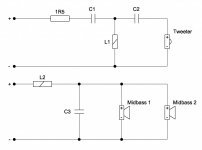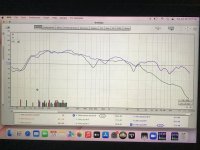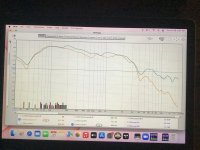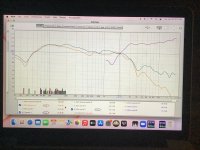Tone?,ah, so I can take measurements of both drivers separately , and how close should the mic be? gated?
Gating would limit the resolution of a low frequency measurement.
https://www.minidsp.com/applications/acoustic-measurements/loudspeaker-measurements
The distance to measure at is a tricky question, all depends on what you are attempting to learn from the measurement.
Quick and dirty- about 8" on axis, with the tweeter and other driver covered with a pillow, will give you a rough idea of the two different 8" driver's response differences.
Past that, gets more interesting- shared enclosure, different distances to baffle edges, interactive Le (voice coil inductance), different driver dispersion patterns, lots of different attributes that require isolation to determine the difference in the raw response of the drivers.
Art
Thanks Galu. If the two different 6.5 play // , that surely was funny to develop! How two different drivers playing the same frequencies on several octaves can not echo ?? A mtm is already complex with two same drivers but with two different that have dissimilar T&S... It is above my understanding.
Are our ears so little sensible...really odd to me. As wrote AllenB the lower woofer must roll off in the highs way early the top driver. Below the Schroder room frequency the parreleling should be less important, the room dictate the behavior somehow and the // drivers fixe the baffle step.
They did had made a lot of measurements...
Are our ears so little sensible...really odd to me. As wrote AllenB the lower woofer must roll off in the highs way early the top driver. Below the Schroder room frequency the parreleling should be less important, the room dictate the behavior somehow and the // drivers fixe the baffle step.
They did had made a lot of measurements...
As wrote AllenB the lower woofer must roll off in the highs way early the top driver.
Yes, the drivers are said to be designed to reproduce different frequencies, thus avoiding the need for a complicated crossover.
That review is a whole lot of blah and 3 facts. sensitivity 90 db, impedance 4 ohms, response 38-38000 hz. No limits. no volume charts. How many db response, +-20 like Radio Shack? On axis off axis response? Harmonic distortion @ 5 w? Review was a waste of electricity.
That review is a whole lot of blah and 3 facts. sensitivity 90 db, impedance 4 ohms, response 38-38000 hz. No limits. no volume charts. How many db response, +-20 like Radio Shack? On axis off axis response? Harmonic distortion @ 5 w? Review was a waste of electricity.
ha. Right?
yeah the review was all adjectives and nothing else. Annoying to say the least
Tone?,
Gating would limit the resolution of a low frequency measurement.
https://www.minidsp.com/applications/acoustic-measurements/loudspeaker-measurements
The distance to measure at is a tricky question, all depends on what you are attempting to learn from the measurement.
Quick and dirty- about 8" on axis, with the tweeter and other driver covered with a pillow, will give you a rough idea of the two different 8" driver's response differences.
Past that, gets more interesting- shared enclosure, different distances to baffle edges, interactive Le (voice coil inductance), different driver dispersion patterns, lots of different attributes that require isolation to determine the difference in the raw response of the drivers.
Art
thanks Art!
Thanks Galu. If the two different 6.5 play // , that surely was funny to develop! How two different drivers playing the same frequencies on several octaves can not echo ?? A mtm is already complex with two same drivers but with two different that have dissimilar T&S... It is above my understanding.
Are our ears so little sensible...really odd to me. As wrote AllenB the lower woofer must roll off in the highs way early the top driver. Below the Schroder room frequency the parreleling should be less important, the room dictate the behavior somehow and the // drivers fixe the baffle step.
They did had made a lot of measurements...
and yet they pulled it off really well. The speaker sounds great.
ill try and take some measurements as Art showed me and see what I come up with
yeah maybe your assessment is correct with the two woofers.
one does have a very small magnet Compared to the other.
Thanks Galu. If the two different 6.5 play // , that surely was funny to develop! How two different drivers playing the same frequencies on several octaves can not echo ?? A mtm is already complex with two same drivers but with two different that have dissimilar T&S... It is above my understanding.
Are our ears so little sensible...really odd to me. As wrote AllenB the lower woofer must roll off in the highs way early the top driver. Below the Schroder room frequency the parreleling should be less important, the room dictate the behavior somehow and the // drivers fixe the baffle step.
They did had made a lot of measurements...
The design is just as likely to be driven by a need to get rid of excess inventory of a driver as by any engineering decision. It wouldn't be the first sub-optimal design passed over to marketing to write a compelling justification/story for.
Certainly to the general population who don't have background knowledge of speaker design or the requirements for a 2-way mtm, the story of
'two different drivers, with different materials, each "specializing" in a different range'
is a lot easier to sell for what appears to be $4.5k/each, than yet another conventional 6.5/1" mtm design using scanspeak discovery level drivers, mdf boxes, and solid but modest crossover design & parts.
The film cap has significantly higher Q than the bipolar electrolytics you replaced and that might account for some of the difference you are hearing. Try adding some resistance in series with the cap. (start small like 0.1 ohm)
Also bearing in mind that depending on how your meter measures capacitance the capacitors leakage current can affect the reading. (Some meters measure capacitance in a simple integrator circuit and calculate the value based on how long it takes to charge to the expected value. If there is leakage this results in a longer charging time and a measurement error..
Also bearing in mind that depending on how your meter measures capacitance the capacitors leakage current can affect the reading. (Some meters measure capacitance in a simple integrator circuit and calculate the value based on how long it takes to charge to the expected value. If there is leakage this results in a longer charging time and a measurement error..
That generally hasn't been my impression of how Proac does business, but it is has been a long time since I have owned any. Decades ago I owned a pair of the original Tablettes, they were rather decent sounding for a smallish bookshelf. (Snappy, and imaged like crazy) I blew one of the woofers with one of my more wayward OTL designs, and they sent me a replacement at rather minimal cost, and quite quickly.The design is just as likely to be driven by a need to get rid of excess inventory of a driver as by any engineering decision. It wouldn't be the first sub-optimal design passed over to marketing to write a compelling justification/story for.
<snip>
The design is just as likely to be driven by a need to get rid of excess inventory of a driver as by any engineering decision. It wouldn't be the first sub-optimal design passed over to marketing to write a compelling justification/story for.
Certainly to the general population who don't have background knowledge of speaker design or the requirements for a 2-way mtm, the story of
'two different drivers, with different materials, each "specializing" in a different range'
is a lot easier to sell for what appears to be $4.5k/each, than yet another conventional 6.5/1" mtm design using scanspeak discovery level drivers, mdf boxes, and solid but modest crossover design & parts.
dude the speaker has got awards. Not that, that is something special in the audio world or anything. And yes there is so much marketing fluff.
and trust me I’m not saying that because I own them. If you knew me I could really care less. I’m not beholden to any company.
most speakers at that cost use SEAS prestige or Scanspeak discovery series drivers.
you have to start paying over $15k for better drivers in commercial loudspeakers.
i didn’t know hardly anything about speaker brands when I went and picked them.
i searched for speakers for two years. Yup you heard right. Two years.
among the brands I heard were.
Dali. Good but dry sounding
B&W 702 pretty good. A bit too piercing
Harbeth. Different models. Amazing reproduction of vocals but fall apart in complex bass.
PMC. Gimmicky and lack of low mid punch. Amazing sound stage tho
Dynaudio. Hurt my ears. Really bright
Martin Logan. Pretty good , bit boxy sounding
Triangle. Not bad. thin sounding?
KEF. Weird mids. just can put my finger on it. Don’t sound natural to me. Even their reference series.
and I heard the Proacs without knowing anything about them. Didn’t stand out really in any aspect. Just didn’t really lack anything. One of the speakers I tried with good mid bass punch. And good timbre.
that’s about it.
Last edited:
The film cap has significantly higher Q than the bipolar electrolytics you replaced and that might account for some of the difference you are hearing. Try adding some resistance in series with the cap. (start small like 0.1 ohm)
Also bearing in mind that depending on how your meter measures capacitance the capacitors leakage current can affect the reading. (Some meters measure capacitance in a simple integrator circuit and calculate the value based on how long it takes to charge to the expected value. If there is leakage this results in a longer charging time and a measurement error..
thanks. I’ll try that out.
i don’t think that’s it. But it could be.
much appreciated.
Tone?,
Gating would limit the resolution of a low frequency measurement.
https://www.minidsp.com/applications/acoustic-measurements/loudspeaker-measurements
The distance to measure at is a tricky question, all depends on what you are attempting to learn from the measurement.
Quick and dirty- about 8" on axis, with the tweeter and other driver covered with a pillow, will give you a rough idea of the two different 8" driver's response differences.
Past that, gets more interesting- shared enclosure, different distances to baffle edges, interactive Le (voice coil inductance), different driver dispersion patterns, lots of different attributes that require isolation to determine the difference in the raw response of the drivers.
Art
ok here are the measurements I took
I measured each woofer with the tweeter and other driver covered with a thick pad of memory foam.
measurements were taken at 8” and 1”.
of course this wasn’t perfect.
oh and mind you this is with the 16uf value on the woofers xo instead of 18uf.
tomorrow I may take measurements again with 18uf in there
addendum. Added a measurement of the tweeter as well l but didn’t cover up the woofers. Started the measurement from 1khz
Attachments
Last edited:
My understanding is that there can be big differences in Loudspeaker performance depending on Amp to Loudspeaker matching.dude the speaker has got awards. Not that, that is something special in the audio world or anything. And yes there is so much marketing fluff.
and trust me I’m not saying that because I own them. If you knew me I could really care less. I’m not beholden to any company.
most speakers at that cost use SEAS prestige or Scanspeak discovery series drivers.
you have to start paying over $15k for better drivers in commercial loudspeakers.
i didn’t know hardly anything about speaker brands when I went and picked them.
i searched for speakers for two years. Yup you heard right. Two years.
among the brands I heard were.
Dali. Good but dry sounding
B&W 702 pretty good. A bit too piercing
Harbeth. Different models. Amazing reproduction of vocals but fall apart in complex bass.
PMC. Gimmicky and lack of low mid punch. Amazing sound stage tho
Dynaudio. Hurt my ears. Really bright
Martin Logan. Pretty good , bit boxy sounding
Triangle. Not bad. thin sounding?
KEF. Weird mids. just can put my finger on it. Don’t sound natural to me. Even their reference series.
and I heard the Proacs without knowing anything about them. Didn’t stand out really in any aspect. Just didn’t really lack anything. One of the speakers I tried with good mid bass punch. And good timbre.
that’s about it.
Also "not all models" in the range of noteworthy brands perform well.
A speaker maker over guy I've been following had a 1k model & a 5k model of a given brand.
He found the 1k model was reasonable and could be improved, while the 5k example sucked and wasn't worth tipping anymore money into it.
Definitely.And it of course also comes down to preference.
we aren’t all gonna like everything
Having already spent most of my years on this planet, deterioration in my ability to hear probably would also play a part.
I've been dabbling with crossover upgrades on used speakers for a little while.
Having worked on a dozen or so, my experience isn't always positive.
Some showed no improvement, others sounded better and yet others performed neutrally.
It's been said that Caps need a burn in period (100 - 200 hours).
This might be true or it might be just designed to work on your psych acoustics experience. I don't know.
I usually go for "new for old" electrolytic to poly caps.
If I think it's worth tipping more in I'll replace the iron core Inductors with air core.
The iron core holds charge and can have significant impact on smudging the sound, but then high value inductancve can be very expensive with air core. The iron core results in smaller/cheaper inductors for a given value.
The experience of many conclude that there isn't a difference, but others advise the sandcast resistors can have a negative affect.
Have you tried Bypass Caps?
I had a project involving vintage speakers valued at over 2k used.
The makeover caused them to go backwards.
In the end I saved things after experimenting with Bypass caps.
Bypass Caps are best used to improve Tweeter performance, but can be extended to other drivers.
Capacitors have more input sonically than just capacitance, and hence availability of various Caps with differing price points.
But then whether you'll here a difference depends on your rig, and can be affected by many variables.
Some worth it, others not, depending on your project
Theoretically the higher the price point, the better the performance.
If you fit an 18uf poly cap into your tweeter circuit you need to choose a price point.
$5, or $18, or $27, or $145, or crazy prices.
Builders have found if you place a 0.01uf Cap of higher quality in parallel with your 18uf Cap you produce a negligible uf variation but introduce higher quality performance into your Cap circuit.
It's reported that poorer quality Caps discharge energy more slowly than others causing smearing or lower clarity to the sound.
A quality Bypass cap can improve discharge performance over a lower quality Cap when fitted in parallel.
Lower uf value Caps are cheaper than higher ones within a given Cap range.
For example a 0.01uf Cap belonging to XYZ range might sell for $15 compared to its 18uf Cap version which might go for $145.
You may achieve up to $145 performance from $15 investment.
This was my experience. The failed Cap upgrade was saved by adding Bypass Caps.
Some say this is subjective others not.
These guys have evaluated a number of caps and use their knowledge to build.
you might find their work interesting.
https://www.humblehomemadehifi.com/Cap.html
Last edited:
- Home
- Loudspeakers
- Multi-Way
- Why would a manufacturer use a 16uf cap that is really 18uf?



